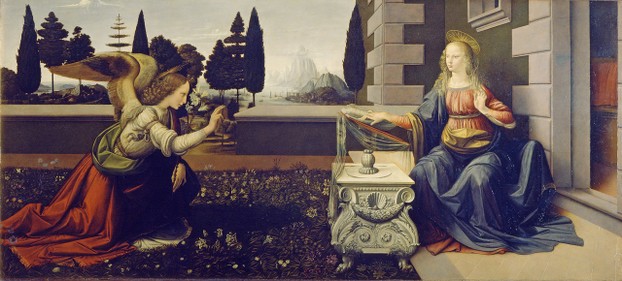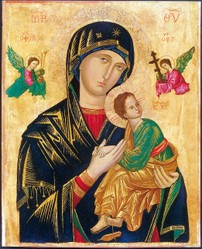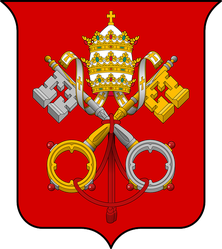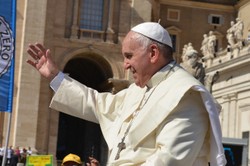Bitter, bittter, O to behold,
The grass to grow
Where the walls of Walsingham
So stately did stand
From a poem attributed to St Philip Howard
The saint was lamenting the devastation wrought by the Reformation, perpetrated by the over-enthusiastic royal commissioner for Norfolk, Roger Townsend, who gained control of the Austin Friars' priory at Walsingham and stripped it bare, leaving it a ruin.
But what was the history of this much loved shrine? Differences exist between historians. In 1959 Dickenson challenged the traditional date of 1061, saying that the founder, Richeldis de Faverches lived in 1130, but there seem to be errors. Traditionally Richeldis lived at the time of Edward the Confessor, who died in 1066, and as she was said to be an Englishwoman this fits ill with her having a clearly Norman name. This to me seems a normanization of a Saxon personage, in keeping with the propensity of the English establishment to belittle our Saxon forebears.She has been recast as a member of the ruling class of a later period and misidentified with the real Richeldis de Faverches who lived in the 1130s.
Historian Bill Flint restores the traditional date of 1061. He notes that the shrine was established at the behest of visionary, Edith the Fair. Only one woman in England had that title, Edith Swanneshals, which means Edith Swan Neck, wife of Earl Harold Godwinson, later to become the last Saxon king of England. She was lady of the manor of Walsingham, in Norfolk, in the 1060s,so she fits in well with this view of the history of the project. She is sometimes called Rychold, a name that means rich and fair, but this name was later Normanised to Richeldis [which means rich and fair] by later writers, so I believe that this Saxon earl's wife was the visionary behind the establishment of the shrine.
The story goes that in 1061 the pious Earl's wife, the Saxon term for a countess, had a series of three visions in which Mary appeared to her to ask her to construct a replica of the holy house at Nazareth as a memorial to the incarnation. After some unsuccessful attempts to erect the structure where Rychold wanted it, the story goes that it was erected by angels overnight at a nearby spot! It seems likely that the builders were spinning her a story, but the simple wooden structure remained and became one of the four main shrines in Europe after Rome, Canterbury and Compostella.
Later on there were more buildings erected. Wayside stations where pilgrims would stop on the way were constructed, and the Austin Friars and later the Franciscans, built priories where the friars would provide care for pilgrims, who went to Walsingham inspired by Mary's promise that whoever prays there will not go away empty handed.
By the sixteenth century all seemed to be going well, and people were oblivious to the storm on the horizon.








 Women of the Gospelson 10/11/2025
Women of the Gospelson 10/11/2025
 Religious Gardenson 08/25/2025
Religious Gardenson 08/25/2025
 Doctor of the Church: John Henry Newmanon 08/03/2025
Doctor of the Church: John Henry Newmanon 08/03/2025
 Restoring the Palm Houseon 07/16/2025
Restoring the Palm Houseon 07/16/2025



Comments
My article suggests that the burned statue was a substitute. The realmstatue survived.
Thank you for your comment below in answer to my previous observation and question.
The ancient statue of Our Lady Mary burned at an execution place disappoints me. Do we know what was done with the statue ashes?
Tyburn in London was the official place of execution. So certain major burnings took place there
Thank you for your comment below, on Dec. 9, 2023, in answer to my previous observation and question.
The second sentence in the first paragraph to the second heading, Destruction and rebirth, considers that "In 1538 the royal commissioners arrived to strip the shrine and priories of their possessions. Any golden ecclesiastical vessels were seized to be melted down, books thrown away and worst of all the ancient wooden statue of Mary venerated since 1061 was taken to London to be burned."
Did the royal commissioners defer to some special "anti" ceremony or date or place in doing the burning of the wooden statue of Our Lady Mary other than on site?
There is to my knowledge no detail about who destroyed the books. Probably people who did not value books of Catholic theology and devotion scruples not to burn them on the fire.
Thank you!
So there was no ecological commitment to recycling what perhaps was fine-quality ink and paper.
Would the domestic fires have been twofold in their purpose, in destroying something deemed worthy of destruction and in providing heat against the cold and for food-making?
The local rubbish tip.books may have been burned on domestic fires.
The second sentence in the first paragraph to the second heading, Destruction and rebirth, considers that "In 1538 the royal commissioners arrived to strip the shrine and priories of their possessions. Any golden ecclesiastical vessels were seized to be melted down, books thrown away and worst of all the ancient wooden statue of Mary venerated since 1061 was taken to London to be burned."
Where might books be "thrown away"?
What might have been -- please excuse the facetiousness, for lack of proper vocabulary not for lack of sympathy for the books and their owners -- 16th-century equivalents of landfills and recycling centers?
Good question, but I don't think that we have an answer to this.
This is somewhat related, because about the moniker fair, and somewhat not related because from a different place and time.
The description fair manifested itself among French speakers around the time of Henry IV (Dec. 13, 1553-May 14, 1610) of France as -- ignoring its possible hairy and just inspirations previously ;-D -- regarding complexions not blighted by smallpox.
Was fair historically in the British Isles regarding complexion, hair or justice?
Would Gentle Swan Edith have been titled Edith the Fair for her complexion, hair or -- particularly with her religiosity and spirituality as revealed through Walsingham -- sense of justice?